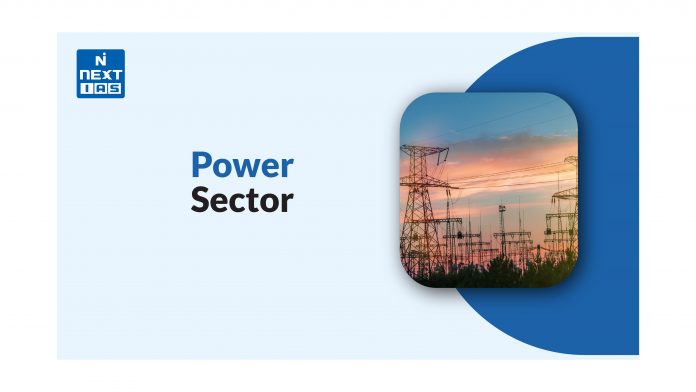The Power Sector is really important for a country’s development and well-being. In India, having a good power infrastructure is crucial for the economy to grow. The goal is to make sure everyone can sustainably afford electricity.
The Ministry of Power has been working hard to make sure there is enough electricity for everyone by connecting the whole country with a national grid, improving the distribution network, and making sure every household has access to electricity.
India has a diverse mix of power sources, including coal, natural gas, oil, hydro, nuclear power, wind, solar, and even agricultural and domestic waste. The demand for electricity in the country is increasing rapidly, and more power plants need to be built to meet this demand.
Important Facts about India’s Power Sector
- India is the third-largest producer and consumer of electricity globally, with an installed power capacity of 411.64 GW as of January 31, 2023.
- Renewable energy capacity in India, including hydro, reached 168.4 GW as of January 31, 2023, accounting for 40.9% of the total installed power capacity.
- This includes 63.3 GW from solar energy, 41.9 GW from wind power, 10.2 GW from biomass, 4.92 GW from small hydropower, 0.52 GW from waste to energy, and 46.85 GW from hydropower.
Systemic Issues in India’s Power Sector
| Issues with Electricity Generation in the Power Sector – High cost of fuel: coal extraction from state-run Coal India has been hindered by delays in environmental clearances, land acquisition issues, and inadequate investment in advanced technologies. – Dependency on Imported Coals: Power companies often have to rely on costly coal imports despite having abundant coal reserves. – High Contribution from Non-renewable Resources: Around 80% of India’s power generation relies on thermal power derived from fossil fuels like coal, natural gas, and diesel. – Aged Power Plants: Many power plants in India are old and inefficient leading to inefficiencies. |
| Issues with Transmission and Distribution in Power Sector – Uneconomical subsidies: Tariffs have not been increased enough to cover the costs of subsidies in the agricultural sector. – High AT&C losses: Electricity distributors (discoms) face high aggregate technical and commercial (AT&C) losses, with some states experiencing losses as high as 40%, while the national average is 27%. – Lack of private sector investment: Poor financial health of discoms has discouraged new investments in the electricity sector, especially from the private sector. – Inadequate Competitiveness: High industrial/commercial tariffs and the cross-subsidy regime have affected the competitiveness of the industrial and commercial sectors. – Poor revenue realization: The wide gap between the average cost of supply and revenue realized has led to outstanding dues of discoms. |
Government Policies & Initiatives Related to Power Sector in India
- In the Union Budget 2022-23, the Indian government allocated Rs. 7,327 crores for the solar power sector, including grid, off-grid, and PM-KUSUM projects.
- Sovereign green bonds were announced in the Union Budget 2022-23, and infrastructure status was given to energy storage systems, including grid-scale battery systems.
- The Green Energy Corridor projects aim to facilitate renewable power evacuation and reshape the grid. As of October 2022, 8,651 km of intra-state transmission lines and 19,558 MVA intra-state substations have been constructed.
- The Ministry of New and Renewable Energy developed a National Portal to encourage rooftop solar (RTS) across the country, allowing residential consumers to apply for rooftop solar without waiting for Discom (electricity distribution company) approval.
- The Production Linked Incentive Scheme (Tranche II) for high-efficiency solar PV modules, with an outlay of Rs. 19,500 crores, was approved and launched.
- Energy-saving initiatives have been implemented, with the distribution of LED bulbs, tube lights, and energy-efficient fans, resulting in significant savings in electricity consumption.
- The deployment of smart meters under the National Smart Grid Mission (NSGM) has exceeded 51.62 lakhs.
- Electrification efforts are supported by schemes like SAUBHAGYA Scheme, Deen Dayal Upadhyay Gram Jyoti Yojana (DDUGJY), Ujwal DISCOM Assurance Yojana (UDAY), and Integrated Power Development Scheme (IPDS).
The Solution to Issues Faced by the Power Sector in India
- Reforms in subsidies, such as providing direct subsidies per acre of land through Direct Benefit Transfer (DBT) for agriculture, could be considered.
- The KUSUM scheme, promoting the use of solar pumps in agriculture and enabling local discoms to buy surplus power from farmers, offers an alternative to the power subsidy model.
- Effective enforcement of cross-subsidy rationalization is necessary.
- The government should actively promote cross-border electricity trade to utilize existing and upcoming generation assets.
- To manage power demand, 100% metering-net metering, smart meters, and metering of electricity supplied to agriculture need to be introduced.
Conclusion
The Indian power sector is poised for a remarkable transformation throughout the current decade (2020-2029) as it experiences substantial shifts in demand growth, energy sources, and market dynamics.
The Ministry of Power is actively working towards replacing coal-based energy generation with renewable sources in 81 thermal units by 2026, with the overarching objective of achieving India’s impressive 500 GW renewable energy target.
These initiatives signify a determined commitment towards a more sustainable and resilient energy future for the nation.









